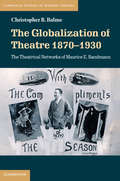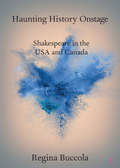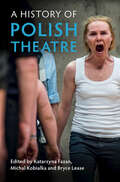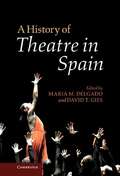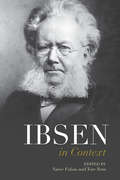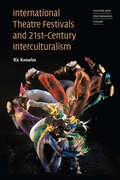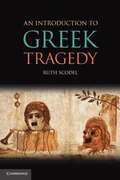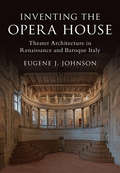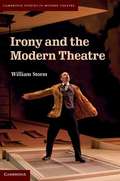- Table View
- List View
The First Part of King Henry IV (The New Cambridge Shakespeare)
by Judith Weil William Shakespeare Herbert WeilThis updated edition offers a strongly theatrical perspective on the origins of Shakespeare's The First Part of King Henry IV and the history of its interpretation. The introduction clarifies the play's surprising, de-centred dramatic structure, questioning the dominant assumption that the drama focuses on the education of Prince Hal. It calls attention to the effects of civil war upon a broad range of relationships. Falstaff's unpredictable vitality is explored, together with important contemporary values of honour, friendship, festivity and reformation. Extensive lexical glosses of obscure, ambiguous or archaic meanings make the rich wordplay accessible. The notes also provide a thorough commentary on Shakespeare's transformation of his sources (particularly Holinshed's Chronicles) and suggest alternative stagings. This updated edition contains a new introductory section by Katharine A. Craik, which describes recent stage, film and critical interpretations, and an updated reading list.
Forging Romantic China
by Peter J. KitsonThe first major cultural study to focus exclusively on this decisive period in modern British-Chinese relations. Based on extensive archival investigations, Peter J. Kitson shows how British knowledge of China was constructed from the writings and translations of a diverse range of missionaries, diplomats, travellers, traders, and literary men and women during the Romantic period. The new perceptions of China that it gave rise to were mediated via a dynamic print culture to a diverse range of poets, novelists, essayists, dramatists and reviewers, including Jane Austen, Thomas Percy, William Jones, S. T. Coleridge, George Colman, Robert Southey, Charles Lamb, William and Dorothy Wordsworth and others, informing new British understandings and imaginings of China on the eve of the Opium War of 1839–42. Kitson aims to restore China to its true global presence in our understandings of the culture and literature of Britain in the late eighteenth and early nineteenth centuries.
Found in Translation
by J. Michael WaltonIn considering the practice and theory of translating plays into English from Classical Greek from a theatrical perspective, Found in Translation also addresses wider issues of transferring any piece of theatre from a source into a target language. The history of translating classical tragedy and comedy, here fully investigated for the first time, demonstrates how through the ages translators have, wittingly or unwittingly, appropriated Greek plays and made them reflect socio-political concerns of their own era. Chapters are devoted to topics including verse and prose, mask and non-verbal language, stage directions and subtext and translating the comic. Among the plays discussed as 'case studies' are Aeschylus' Agamemnon, Sophocles' Oedipus Tyrannus and Euripides' Medea and Alcestis. The book concludes with a consideration of the boundaries between 'translation' and 'adaptation', followed by an Appendix of every translation of Greek tragedy and comedy into English from the 1550s to the present day.
The Fragility of Goodness: Luck and Ethics in Greek Tragedy and Philosophy
by Martha C. NussbaumThis book is a study of ancient views about "moral luck. " It examines the fundamental ethical problem that many of the valued constituents of a well-lived life are vulnerable to factors outside a person's control, and asks how this affects our appraisal of persons and their lives. The Greeks made a profound contribution to these questions, yet neither the problems nor the Greek views of them have received the attention they deserve. This updated edition contains a new preface.
French Visual Culture and the Making of Medieval Theater
by Laura WeigertThis book revives what was unique, strange and exciting about the variety of performances that took place in the realms of the French kings and Burgundian dukes. Laura Weigert brings together a wealth of visual artifacts and practices to explore this tradition of late medieval performance located not in 'theaters' but in churches, courts, and city streets and squares. By stressing the theatricality rather than the realism of fifteenth-century visual culture and the spectacular rather than the devotional nature of its effects, she offers a new way of thinking about late medieval representation and spectatorship. She shows how images that ostensibly document medieval performance instead revise its characteristic features to conform to a playgoing experience that was associated with classical antiquity. This retrospective vision of the late medieval performance tradition contributed to its demise in sixteenth-century France and promoted assumptions about medieval theater that continue to inform the contemporary disciplines of art and theater history.
George Bernard Shaw in Context
by Brad KentWhen Shaw died in 1950, the world lost one of its most well-known authors, a revolutionary who was as renowned for his personality as he was for his humour, humanity, and rebellious thinking. He remains a compelling figure who deserves attention not only for how influential he was in his time, but for how relevant he is to ours. This collection sets Shaw's life and achievements in context, with 42 scholarly essays devoted to subjects that interested him and defined his work. Contributors explore a wide range of themes, moving from factors that were formative in Shaw's life, to the artistic work that made him most famous and the institutions with which he worked, to the political and social issues that consumed much of his attention, and, finally, to his influence and reception. Presenting fresh material and arguments, this collection will point to new directions of research for future scholars.
The Globalization of Theatre 1870–1930: The Theatrical Networks of Maurice E. Bandmann (Cambridge Studies in Modern Theatre)
by Christopher B. BalmeBetween 1895 and 1922 the Anglo-American actor and manager, Maurice E. Bandmann (1872–1922) created a theatrical circuit that extended from Gibraltar to Tokyo and included regular tours to the West Indies and South America. With headquarters in Calcutta and Cairo and companies listed on the Indian stock exchange, his operations represent a significant shift towards the globalization of theatre. This study focuses on seven key areas: family networks; the business of theatrical touring; the politics of locality; repertoire and publics; an ethnography of itinerant acting; legal disputes and the provision of theatrical infrastructure. It draws on global and transnational history, network theory and analysis as well as in-depth archival research to provide a new approach to studying theatre in the age of empire.
Greek Theatre Performance
by David WilesIn this book, David Wiles introduces ancient Greek theater to students and enthusiasts interested in knowing how the plays were performed. Theater was a ceremony bound up with fundamental activities in ancient Athenian life and Wiles explores those elements that created the theater of the time. Actors rather than writers are the book's main concern and Wiles examines how the actor used the resources of story-telling, dance, mask, song and visual action to create a large-scale event that would shape the life of the citizen community.
Greek Tragic Style
by R. B. RutherfordGreek tragedy is widely read and performed, but outside the commentary tradition detailed study of the poetic style and language of Aeschylus, Sophocles and Euripides has been relatively neglected. This book seeks to fill that gap by providing an account of the poetics of the tragic genre. The author describes the varied handling of spoken dialogue and of lyric song; major topics such as vocabulary, rhetoric and imagery are considered in detail and illustrated from a broad range of plays. The contribution of the chorus to the dramas is also discussed. Characterisation, irony and generalising statements are treated in separate chapters and these topics are illuminated by comparisons which show not only what is shared by the three major dramatists but also what distinguishes their practice. The book sheds light both on the genre as a whole and on many particular passages.
Hamlet (The New Cambridge Shakespeare)
by William ShakespearePhilip Edwards deals succinctly with the exhaustive commentary and controversy which Hamlet has provoked in the manifestation of its tragic energy. Robert Hapgood has contributed a new section on prevailing critical and performance approaches to the play in this updated edition. He discusses recent film and stage performances and actors of the Hamlet role as well as directors of the play. His account of new scholarship stresses the role of memory in the play and the impact of feminist and performance studies upon it. [This text is listed as an example that meets Common Core Standards in English language arts in grades 11-12 at http://www.corestandards.org.]
Harrison Birtwistle's Operas and Music Theatre
by David BeardDavid Beard presents the first definitive survey of Harrison Birtwistle's music for the opera house and theatre, from his smaller-scale works, such as Down by the Greenwood Side and Bow Down, to the full-length operas, such as Punch and Judy, The Mask of Orpheus and Gawain. Blending source study with both music analysis and cultural criticism, the book focuses on the sometimes tense but always revealing relationship between abstract musical processes and the practical demands of narrative drama, while touching on theories of parody, narrative, pastoral, film, the body and community. Each stage work is considered in terms of its own specific musico-dramatic themes, revealing how compositional scheme and dramatic conception are intertwined from the earliest stages of a project's genesis. The study draws on a substantial body of previously undocumented primary sources and goes beyond previous studies of the composer's output to include works unveiled from 2000 onwards.
Haunting History Onstage: Shakespeare in the USA and Canada (Elements in Shakespeare Performance)
by Regina BuccolaIn 2016, Chicago Shakespeare Theater and the Stratford Festival of Canada mounted marathons through Shakespearean history to commemorate the 400th anniversary of the death of Shakespeare with Tug of War and Breath of Kings. Both productions invited parallels to contemporary political events in their promotion and design, just as the original performances of these works in the Shakespearean era used past events to comment on present realities. Endurathons for cast and audience alike, Tug of War and Breath of Kings used double-casting, stylized treatments of violence and 'firsts' for each company to sweeten the bitter pill of these historical narratives.
A History of Japanese Theatre
by Jonah SalzJapan boasts one of the world's oldest, most vibrant and most influential performance traditions. This accessible and complete history provides a comprehensive overview of Japanese theatre and its continuing global influence. Written by eminent international scholars, it spans the full range of dance-theatre genres over the past fifteen hundred years, including noh theatre, bunraku puppet theatre, kabuki theatre, shingeki modern theatre, rakugo storytelling, vanguard butoh dance and media experimentation. The first part addresses traditional genres, their historical trajectories and performance conventions. Part II covers the spectrum of new genres since Meiji (1868–), and Parts III to VI provide discussions of playwriting, architecture, Shakespeare, and interculturalism, situating Japanese elements within their global theatrical context. Beautifully illustrated with photographs and prints, this history features interviews with key modern directors, an overview of historical scholarship in English and Japanese, and a timeline. A further reading list covers a range of multimedia resources to encourage further explorations.
A History of Polish Theatre
by Katarzyna Fazan Michal Kobialka Bryce LeasePoland is celebrated internationally for its rich and varied performance traditions and theatre histories. This groundbreaking volume is the first in English to engage with these topics across an ambitious scope, incorporating Staropolska, the Polish-Lithuanian Commonwealth, the Enlightenment and Romanticism within its broad ambit. The book also discusses theatre cultures under socialism, the emergence of canonical practitioners and training methods, the development of dramaturgical forms and stage aesthetics and the political transformations attending the ends of the First and Second World Wars. Subjects of far-reaching transnational attention such as Jerzy Grotowski and Tadeusz Kantor are contextualised alongside theatre makers and practices that have gone largely unrecognized by international readers, while the participation of ethnic minorities in the production of national culture is given fresh attention. The essays in this collection theorise broad historical trends, movements, and case studies that extend the discursive limits of Polish national and cultural identity.
A History of Theatre in Spain
by Maria M. Delgado David T. GiesLeading theater historians and practitioners map a theatrical history that moves from the religious tropes of Medieval Iberia to the postmodern practices of twenty-first-century Spain. Considering work across the different languages of Spain, from vernacular Latin to Catalan, Galician and Basque, this history engages with the work of actors and directors, designers and publishers, agents and impresarios, and architects and ensembles, in indicating the ways in which theater has both commented on and intervened in the major debates and issues of the day. Chapters consider paratheatrical activities and popular performance, such as the comedia de magia and flamenco, alongside the works of Spain's major dramatists, from Lope de Vega to Federico García Lorca. Featuring revealing interviews with actress Nuria Espert, director Lluís Pasqual and playwright Juan Mayorga, it positions Spanish theater within a paradigm that recognizes its links and intersections with wider European and Latin American practices.
Home on the Stage
by Nicholas GreneAs a serious drama set in an ordinary middle-class home, Ibsen's A Doll's House established a new politics of the interior that was to have a lasting impact upon twentieth-century drama. In this innovative study, Nicholas Grene traces the changing forms of the home on the stage through nine of the greatest of modern plays and playwrights. From Chekhov's The Cherry Orchard through to Williams's A Streetcar Named Desire, domestic spaces and personal crises have been employed to express wider social conditions and themes of class, gender and family. In the later twentieth century and beyond, the most radically experimental dramatists created their own challenging theatrical interiors, including Beckett in Endgame, Pinter in The Homecoming and Parks in Topdog/Underdog. Grene analyses the full significance of these versions of domestic spaces to offer fresh insights into the portrayal of the naturalistic environment in modern drama.
Ibsen in Context (Literature in Context)
by Narve Fulsås Tore RemHenrik Ibsen, the 'Father of Modern Drama', came from a seemingly inauspicious background. What are the key contexts for understanding his appearance on the world stage? This collection provides thirty contributions from leading scholars in theatre studies, literary studies, book history, philosophy, music, and history, offering a rich interdisciplinary understanding of Ibsen's work, with chapters ranging across cultural and aesthetic contexts including feminism, scientific discovery, genre, publishing, music, and the visual arts. The book ends by charting Ibsen's ongoing globalization and gives valuable overviews of major trends within Ibsen studies. Accessibly written, while drawing on the most recent scholarship, Ibsen in Context provides unique access to Ibsen the man, his works, and their afterlives across the world.
Ibsen’s Houses
by Mark B. SandbergHenrik Ibsen's plays came at a pivotal moment in late nineteenth-century European modernity. They engaged his public through a strategic use of metaphors of house and home, which resonated with experiences of displacement, philosophical homelessness, and exile. The most famous of these metaphors - embodied by the titles of his plays A Doll's House, Pillars of Society, and The Master Builder - have entered into mainstream Western thought in ways that mask the full force of the reversals Ibsen performed on notions of architectural space. Analyzing literary and performance-related reception materials from Ibsen's lifetime, Mark B. Sandberg concentrates on the interior dramas of the playwright's prose-play cycle, drawing also on his selected poems. Sandberg's close readings of texts and cultural commentary present the immediate context of the plays, provide new perspectives on them for international readers, and reveal how Ibsen became a master of the modern uncanny.
The Illustrated Shakespeare, 1709-1875
by Stuart SillarsIllustrations have been an important element of many of the most extensively read editions of Shakespeare's plays, from the frontispieces to Nicholas Rowe's 1709 edition to the multiple images placed within the text of Victorian editions. Through symbols the illustrations have explored language and character; by allusion to earlier paintings they have offered critical readings; and by gesture, setting and costume they have redesigned the plays within the visual vocabulary of their own times. In all these ways they offer important exchanges with contemporary social, aesthetic and critical concerns, and, despite being largely ignored by scholars, are central to the plays' reception. Highly illustrated, including many images not previously reproduced, the book allows the reader to share the experience of early readers of the plays. Building on the author's earlier work in Painting Shakespeare it offers a fresh address to the tradition of visual criticism and assimilation of Shakespeare's plays.
International Theatre Festivals and Twenty-First-Century Interculturalism (Theatre and Performance Theory)
by Ric KnowlesRic Knowles' study is a politically urgent, erudite intervention into the ecology of theatre and performance festivals in an international context. Since the 1990s there has been an exponential increase in the number and type of festivals taking place around the world. Events that used merely to be events are now 'festivalized': structured, marketed, and promoted in ways that stress urban centres as tourist destinations and “creative cities” as targets of corporate enterprise. Ric Knowles examines the structure, content, and impact of international festivals that draw upon and represent multiple cultures and the roles they play in one of the most urgent processes of our times: intercultural negotiation and exchange. Covering a vast geographical sweep and exploring festival models both new and ancient, the work sets compelling new standards of practice for post-pandemic festivals.
An Introduction to Greek Tragedy
by Ruth ScodelThis book provides a brief and accessible introduction to Greek tragedy for students and general readers alike. Whether readers are studying Greek culture, performing a Greek tragedy, or simply interested in reading a Greek play, this book will help them to understand and enjoy this challenging and rewarding genre. An Introduction to Greek Tragedy provides background information; helps readers appreciate, enjoy, and engage with the plays themselves; and gives them an idea of the important questions in current scholarship on tragedy. Ruth Scodel seeks to dispel misleading assumptions about tragedy, stressing how open the plays are to different interpretations and reactions. In addition to general background, the book also includes chapters on specific plays, both the most familiar titles and some lesser-known plays - Persians, Helen, and Orestes - in order to convey the variety that the tragedies offer readers.
Inventing the Opera House: Theater Architecture In Renaissance And Baroque Italy
by Eugene J. JohnsonIn this book, Eugene J. Johnson traces the invention of the opera house, a building type of world wide importance. <P><P>Italy laid the foundation theater buildings in the West, in architectural spaces invented for the commedia dell'arte in the sixteenth century, and theaters built to present the new art form of opera in the seventeenth. Rulers lavished enormous funds on these structures. Often they were among the most expensive artistic undertakings of a given prince. They were part of an upsurge of theatrical invention in the performing arts. At the same time, the productions that took place within the opera house could threaten the social order, to the point where rulers would raze them. Johnson reconstructs the history of the opera house by bringing together evidence from a variety of disciplines, including music, art, theatre, and politics. Writing in an engaging manner, he sets the history of the opera house within its broader early modern social context.<P> This is the only book, since the 1930s, to cover this subject, and the only English language one to ever be produced.<P> Sets the subject into a broad context of the arts, politics, and social history of the period.<P> The book aims to reach both specialists and the general reader, making it appealing to those who know the field well and those who do not care to plow through scholarly jargon.
Irony and the Modern Theatre
by William StormIrony and theatre share intimate kinships, not only regarding dramatic conflict, dialectic or wittiness, but also scenic structure and the verbal or situational ironies that typically mark theatrical speech and action. Yet irony today, in aesthetic, literary and philosophical contexts especially, is often regarded with skepticism - as ungraspable, or elusive to the point of confounding. Countering this tendency, Storm advocates a wide-angle view of this master trope, exploring the ironic in major works by playwrights including Chekhov, Pirandello and Brecht, and in notable relation to well-known representative characters in drama from Ibsen's Halvard Solness to Stoppard's Septimus Hodge and Wasserstein's Heidi Holland. To the degree that irony is existential, its presence in the theatre relates directly to the circumstances and the expressiveness of the characters on stage. This study investigates how these key figures enact, embody, represent and personify the ironic in myriad situations in the modern and contemporary theatre.
A Jacobean Company and Its Playhouse
by Eva GriffithEva Griffith's book fills a major gap concerning the world of Shakespearean drama. It tells the previously untold story of the Servants of Queen Anna of Denmark, a group of players parallel to Shakespeare's King's Men, and their London playhouse, The Red Bull. Built in vibrant Clerkenwell, The Red Bull lay within the northern suburbs of Jacobean London, with prostitution to the west and the Revels Office to the east. Griffith sets the playhouse in the historical context of the Seckford and Bedingfeld families and their connections to the site. Utilising a wealth of primary evidence including maps, plans and archival texts, she analyses the court patronage of figures such as Sir Robert Sidney, Queen Anna's chamberlain, alongside the company's members, function and repertoire. Plays performed included those by Webster, Dekker and Heywood -- entertainments characterized by spectacle, battle sequence and court-room drama, alongside London humor and song.
Julius Caesar (The New Cambridge Shakespeare)
by Marvin Spevack William ShakespeareMarga Munkelt has added a new section and pictures to the Introduction of this updated edition of Julius Caesar. It surveys stage and critical interpretations since the 1980's of Shakespeare's most famous Roman play. The reading list has also been brought up to date.

